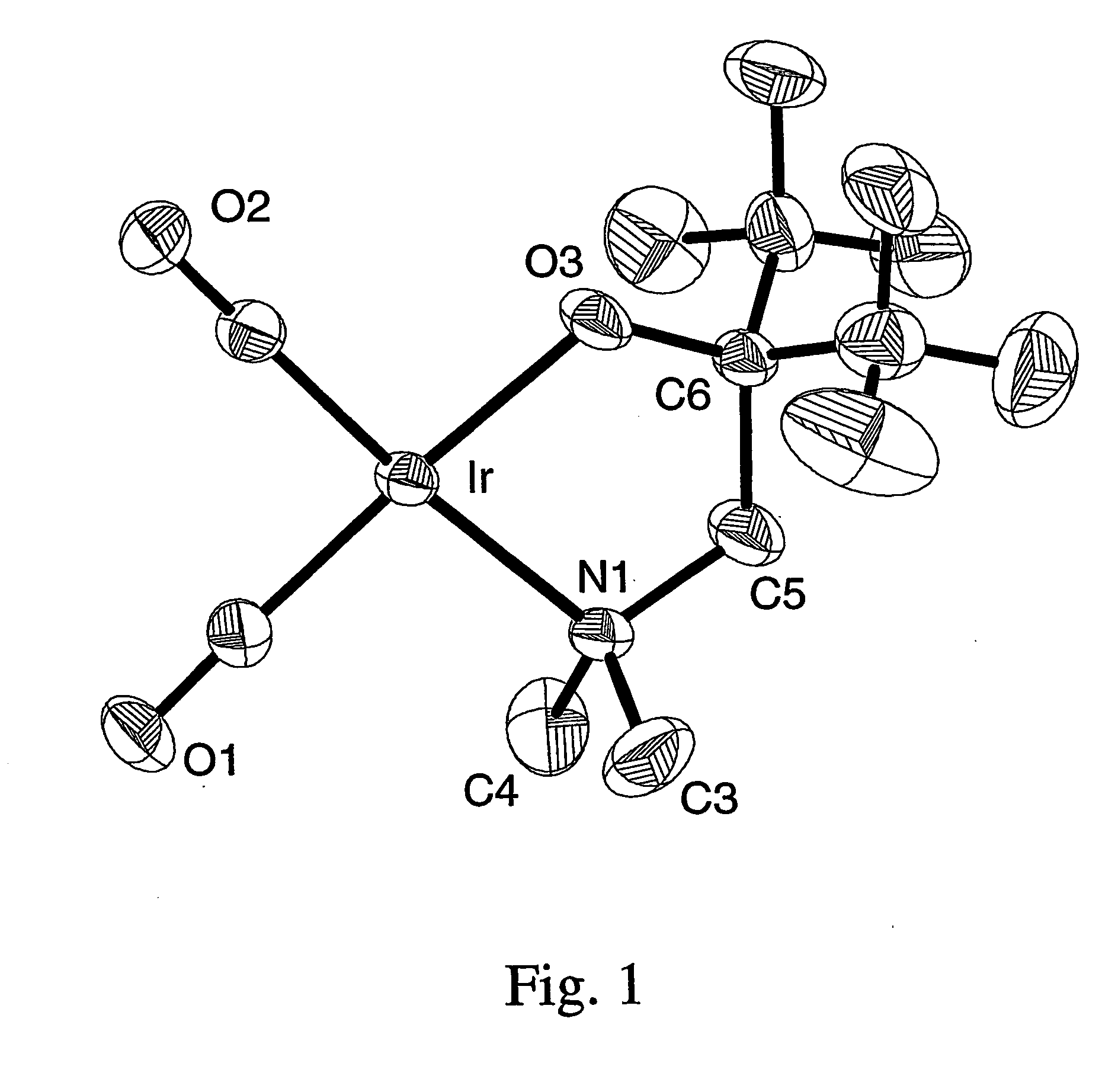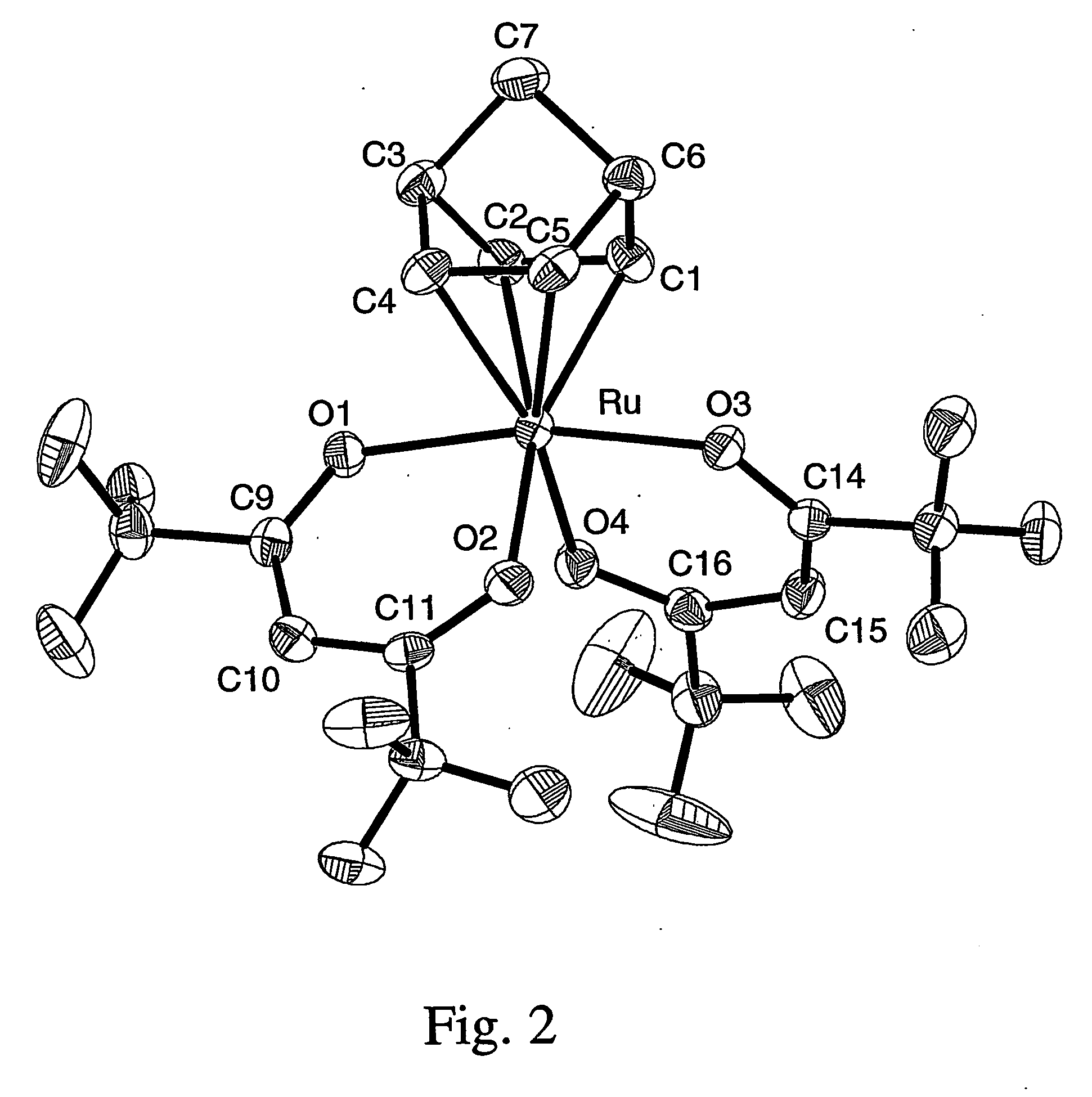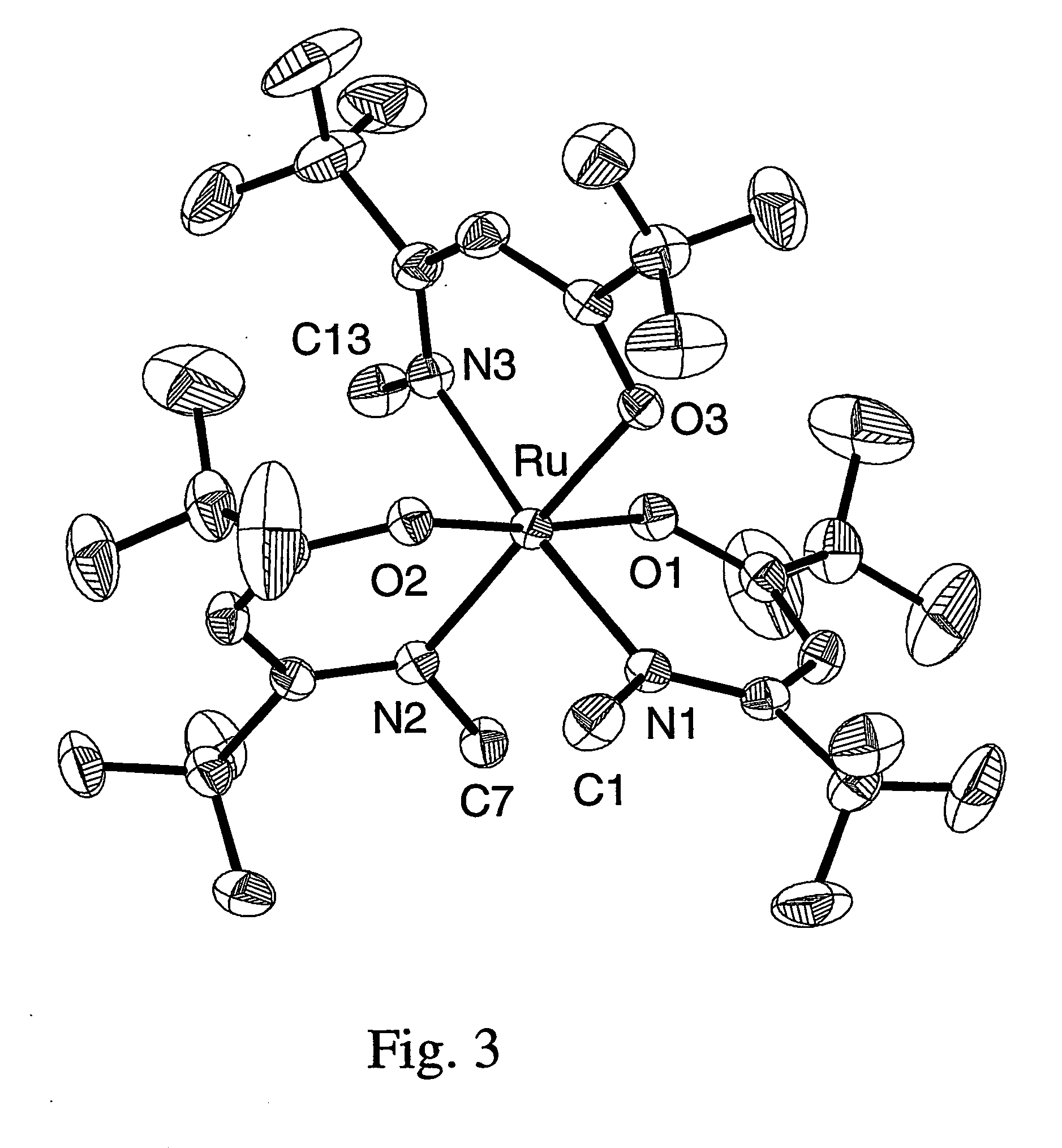Volatile noble metal organometallic complexes
a noble metal and complex technology, applied in the field ofvolatile noble metal organometallic complexes, can solve the problems of limited development as industrial standard, increased toxicity of oso, and use of source reagents
- Summary
- Abstract
- Description
- Claims
- Application Information
AI Technical Summary
Benefits of technology
Problems solved by technology
Method used
Image
Examples
example 1
Synthesis of [Ir(COD)(FBC2)2], R=CF3, R1=Et.
Sodium hydroxide (24 mg, 1.0 mmol) was suspended in 20 mL of THF. To this was slowly added 0.15 g of ketoimine ligand HOC(CF3)═CHC(CF3)═NEt (0.64 mmol) in THF (20 mL). The mixture was stirred at room temperature for 40 min. The solution was then filtered and the filtrate was transferred into a 100 mL reaction flask containing a suspension of [Ir(COD)(μ-Cl)]2 (0.2 g, 0.29 mmol) in THF (50 mL). This mixture was stirred at room temperature for 4 hours, giving a dark-red solution alone with an off-white NaCl precipitate. THF was removed under vacuum and the resulting oily residue was taken into 35 mL of hexane. The solution was washed with distilled water (2×20 mL), and then treated with drying agent Na2SO4, evaporation of hexane and sublimation at 50° C. and 140 mtorr to give 0.23 g of dark red iridium compound [Ir(COD){HOC(CF3)═CHC(CF3)═NEt}] (0.43 mmol, 74%).
Spectral data: MS (EI, 193Ir), m / z 535, M+. 1H NMR (CDCl3, 333 K): δ 6.03 (s, ...
example 2
Synthesis of [Ir(COD)(FBC3)2], R1=Pr.
The preparation procedures were identical to that of example 1, using 0.2 g of [Ir(COD)(μ-Cl)]2 (0.29 mmol), 0.17 g of iminoalcohol HO(CF3)2CH2N(Me)═NPr (0.64 mmol), 0.1 g of NaOH and 50 mL of THF. For work-up, the reaction mixture was extracted with hexane, followed by drying and evaporation of hexane, the solid residue was then purified by vacuum sublimation (120 mtorr, 43° C.), giving 0.28 g of yolk yellow [Ir(COD){O(CF3)2CH2N(Me)═NEt}] (0.50 mmol, 86%).
Spectral data: MS (EI, 193Ir), m / z 565, M+. 1H NMR (C6D6, 298K): δ 4.50˜4.48 (m, 2H, CH), 3.02˜2.98 (m, 2H, CH), 2.80 (t, 2H, 1JHH=8 Hz, NCH2), 2.70 (s, 2H, CH2), 2.23˜2.10 (m, 4H, CH2(COD)), 1.51˜1.39 (m, 6H, CH2(COD) & NCH2CH2), 1.27 (s, 3H, CH3), 0.64 (t, 3H, 1JHH=7.2 Hz, NCH2). 13C NMR (CDCl3, 298K): δ 176.0 (s, 1C, CN), 125.5 (q, 2C, 1JCF=292 Hz, CF3), 77.1 (m, 1C, 2JCF=28 Hz, COH), 72.3 (s, 2C, CH), 54.7 (s, 1C, NCH2), 52.6 (s, 2C, CH), 45.6 (s, 1C, CH2), 33.2 (s, 2C, CH2(COD)), 30.4...
example 3
Synthesis of [Ir(COD)(FBC4)2], R1=Me.
The procedures were identical to that of example 1, using 0.2 g of [Ir(COD)(μ-Cl)]2 (0.29 mmol), 0.14 g of aminoalcohol HO(CF3)2CH2NMe2 (0.64 mmol), 0.1 g of NaOH and 50 mL of THF. After removal of THF, the residue was extracted with pentane (2×20 mL), and the pentane solution was evaporated under vacuum to give 0.25 g of yellow solid [Ir(COD){O(CF3)2CH2NMe2}] (yield 82%), which was further purified by vacuum sublimation at 57° C. and 150 mtorr.
Spectral data: MS (EI, 193Ir), m / z 525, M+. 1H NMR (C6D6, 298K): δ 4.48˜4.45 (m, 2H, CH(COD)), 2.72˜2.69 (m, 2H, CH(COD)), 2.39 (s, 1H, CH2), 2.18˜2.02 (m, 4H, CH2(COD)), 1.80 (s, 6H, CH3), 1.43˜1.37 (m, 4H, CH2(COD)). 13C NMR (CDCl3, 298K): δ 124.72 (q, 2C, 1JCF=290 Hz, CF3), 88.87 (m, 1C, 2JCF=27 Hz, CO), 67.01 (s, 2C, CH(COD)), 65.60 (s, 1C, NCH2), 54.10 (s, 2C, CH(COD)), 50.53 (s, 2C, CH3), 32.44 (s, 2C, CH2(COD)), 30.34(s, 2C, CH2(COD)). 19F NMR (C6D6, 298K): δ−77.34 (s, 6F, CF3). Anal. Calcd. fo...
PUM
| Property | Measurement | Unit |
|---|---|---|
| Temperature | aaaaa | aaaaa |
| Temperature | aaaaa | aaaaa |
| Temperature | aaaaa | aaaaa |
Abstract
Description
Claims
Application Information
 Login to View More
Login to View More - R&D
- Intellectual Property
- Life Sciences
- Materials
- Tech Scout
- Unparalleled Data Quality
- Higher Quality Content
- 60% Fewer Hallucinations
Browse by: Latest US Patents, China's latest patents, Technical Efficacy Thesaurus, Application Domain, Technology Topic, Popular Technical Reports.
© 2025 PatSnap. All rights reserved.Legal|Privacy policy|Modern Slavery Act Transparency Statement|Sitemap|About US| Contact US: help@patsnap.com



